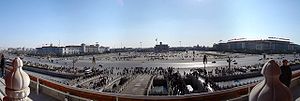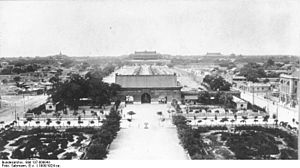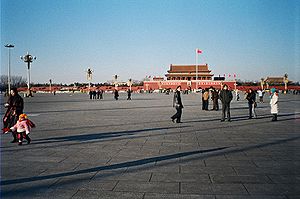- Tiananmen Square
-
For the 1989 protests, see Tiananmen Square protests of 1989.
Tiananmen Square 
Tiananmen Square as seen from the Tian'an Gate Chinese name Traditional Chinese 天安門廣場 Simplified Chinese 天安门广场 Transcriptions Mandarin - Hanyu Pinyin Tiān'ānmén Guǎngchǎng - Wade–Giles T'ian'anmen Kuangch'ang - IPA tʰjɛ́n.ánmə̌n gẁɑ̃tʂʰɑ̃ Cantonese (Yue) - Jyutping tin1 on1 mun4 gwong2 coeng4 - IPA tɪ́nʔɔ́ːnmʊ̄n.gwɔ̌ːŋtsʰɔ̯ːŋ Manchu name Manchu abkai elhe obure duka Tiananmen Square is a large city square in the center of Beijing, China, named after the Tiananmen Gate (Gate of Heavenly Peace) located to its North, separating it from the Forbidden City. Tiananmen Square is the third largest city square in the world (440,000 m² - 880m by 500m). It has great cultural significance as it was the site of several important events in Chinese history. Outside China, the square is best known in recent memory as the focal point of the Tiananmen Square protests of 1989, a pro-democracy movement which ended on 4 June 1989 with the declaration of martial law in Beijing by the government and the death of at least hundreds of protesters.[1][2]
Contents
History
 Tiananmen Square in the early 20th century, with the Gate of China, later removed in the 1950s, in the place of the present-day Mao Zedong Mausoleum.
Tiananmen Square in the early 20th century, with the Gate of China, later removed in the 1950s, in the place of the present-day Mao Zedong Mausoleum.
The Tiananmen Gate to the Forbidden City was built in 1415 during the Ming Dynasty. Towards the demise of the Ming Dynasty, heavy fighting between Li Zicheng and the early Qing emperors damaged (or perhaps destroyed) the gate. The Tian'anmen square was designed and built in 1651, and has since enlarged four times its original size in the 1950s.[3][4]
Near the centre of today's square, stood the "Great Ming Gate", the southern gate to the Imperial City, renamed "Great Qing Gate" during the Qing Dynasty, and "Gate of China" during the Republic of China era. Unlike the other gates in Beijing, such as the Tiananmen and the Qianmen, this was a purely ceremonial gateway, with three arches but no ramparts, similar in style to the ceremonial gateways found in the Ming Dynasty Tombs. This gate had a special status as the "Gate of the Nation", as can be seen from its successive names. It normally remained closed, except when the Emperor passed through. Commoner traffic was diverted to two side gates at the northern and eastern ends of today's square, respectively. Because of this diversion in traffic, a busy marketplace, called Chessgrid Streets developed in the big, fenced square to the south of this gate.
British and French troops who invaded Beijing in 1860 pitched camp near the gate and briefly considered burning down the gate and the entire Forbidden City. They decided ultimately to spare the palace and to burn instead the emperor's Old Summer Palace. The Qing emperor eventually agreed to let the foreign powers establish headquarters in the area. During the Boxer Rebellion of 1900 the siege badly damaged the office complexes and several ministries were burnt down. In the conflict's denouement, the area became a space for foreign troops to assemble their armies and horses.
In the early 1950s, the Gate of China was demolished, allowing for the enlargement of the square. In November 1958 a major expansion of Tiananmen Square started, which was completed after only 1 month, in August 1959. This followed the vision of Mao Zedong to make the square the largest and most spectacular in the world, and intended to hold over 500,000 people. In that process, a large number of residential buildings and other structures have been demolished.[5] On its southern edge, the Monument to the People's Heroes has been erected. Concomitantly, as part of the Ten Great Buildings constructed between 1958-59 to commemorate the ten year anniversary of the People's Republic of China, the Great Hall of the People and the Revolutionary History Museum (now National Museum of China) were erected on the western and eastern sides of the square.[5]
The year after Mao's death in 1976, a Mausoleum was built near the site of the former Gate of China, on the main north-south axis of the square. In connection with this project, the square was further increased in size to become fully rectangular and being able to accommodate 600,000 persons.[5]
The urban context of the square was altered in the 1990s with the construction of National Grand Theatre in its vicinity and the expansion of the National Museum.[5]
Configuration
Used as a massive meeting place since its creation, its flatness is contrasted by the 38-meter (125 ft) high Monument to the People's Heroes, and the Mausoleum of Mao Zedong.[3] The square lies between two ancient, massive gates: the Tian'anmen to the north and the Zhengyangmen, better known as Qianmen to the south. Along the west side of the Square is the Great Hall of the People. Along the east side is the National Museum of China (dedicated to Chinese history predating 1919). Chang'an Avenue, which is used for parades, lies between the Tian'anmen and the Square. Trees line the east and west edges of the Square, but the square itself is open, with neither trees nor benches. The Square is lit with large lampposts which are fitted with video cameras. It is heavily monitored by uniformed and plain clothes policemen.
Events
Tiananmen Square has been the site of a number of political events and student protests. These include the May Fourth Movement in 1919; the proclamation of the People's Republic of China by Mao Zedong on October 1, 1949; annual mass military displays on all subsequent National Days until October 1, 1959; the 1984 military parade for the 35th anniversary of the People's Republic of China, the 50th anniversary in 1999, and the 60th anniversary in 2009; the Tiananmen Square protests in 1976 after the death of premier Zhou Enlai; and the Tiananmen Square Protests of 1989.
The protests of 1989 resulted in the massacre of Chinese protesters in the streets to the west of the square and adjacent areas. There are reports where soldiers opened fire on protesters, killing 400–800, and perhaps many more.[1][2] Eyewitness accounts of the events on the night of June 3 and the early morning of June 4, 1989 continue to emerge from former student leaders and intellectuals, broadening the scope of the original reporting of the massacre by Western media outlets. This was the scene for the iconic image of Tank Man, where a column of PLA tanks was stopped in its tracks by a protester. No one knows if the man in the image is still alive.[6] Further reports show that the theatre of the massacre spanned across Beijing, and was densely concentrated on Chang'an Avenue, literally the "Eternal Peace Street," or the main approach to Tiananmen gate where citizens returned to locate missing protesters driven from the square hours before. Video footage shows the military repeatedly opening fire here on unarmed citizens and medical personnel advancing toward Tiananmen Square to locate the missing and assist the wounded.[7]
Gallery
-
Monument to the People's Heroes and the Great Hall of the People
-
Tiananmen gate to the Forbidden City with reviewing stands in front
References
- ^ a b Miles, James (2 June 2009). "Tiananmen killings: Were the media right?". BBC News. http://news.bbc.co.uk/1/hi/8057762.stm. Retrieved 3 November 2010.
- ^ a b Jan Wong, Red China Blues, Random House 1997, p.278
- ^ a b Safra, J. (Ed.). (2003). Tiananmen Square. In New Encyclopædia Britannica, The (15th ed., Chicago: Vol. 11). Encyclopædia Britannica INC. p. 752. Britannica Online version
- ^ "Tiananmen Square". Britannica Concise Encyclopedia. 2007. http://encyclopedia2.tfd.com/Tiananmen+Square. Retrieved 2008-08-03.
- ^ a b c d Li, M. Lilliam; Dray-Novey, Alison J.; Kong, Haili:Beijing: From Imperial Capital to Olympic City, Palgrave, 2007, ISBN 978-1-4039-6473-1
- ^ "Tiananmen Beijing Massacre Archive". http://www.64memo.com/d/Default.aspx?tabid=194&language=en-US.
- ^ "The Tank Man". PBS Frontline. http://www.pbs.org/wgbh/pages/frontline/tankman.
External links
- Video-1 detailing the Tiananmen Square Massacre in 1989
- Video-2 detailing the Tiananmen Square Massacre in 1989
- Tiananmen Square
Coordinates: 39°54′12″N 116°23′30″E / 39.90333°N 116.39167°E
Categories:- Squares in Beijing
- Visitor attractions in Beijing
- National squares
- Revolution landmarks
- Tiananmen Square
Wikimedia Foundation. 2010.










